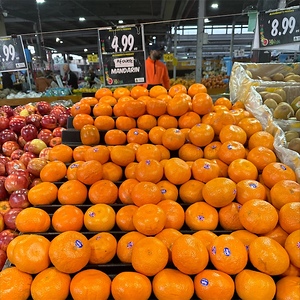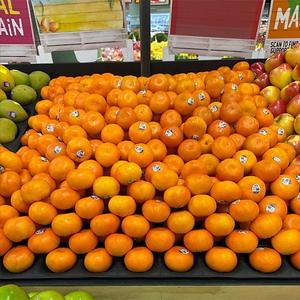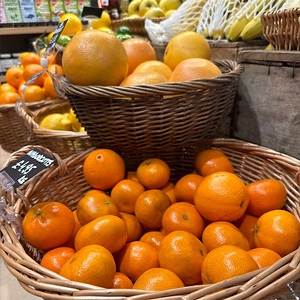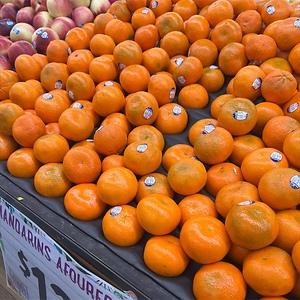


Afourer Mandarins
Estimated Inventory, lb : 0
Description/Taste
Afourer mandarins are small to medium in size, averaging 5 to 6 centimeters in diameter, and have an oblate, slightly flattened appearance with a faint asymmetrical shape. The variety’s skin, also known as the rind, is thin, smooth, taut, and glossy, covered in large prominent oil glands, giving the surface a pebbled feel. The rind should be mostly firm to the touch with a slight give, and ripens to shades of vibrant orange-red. It is also tightly adhered to the flesh but easy to peel. Underneath the skin, the orange-red flesh is divided into 10 to 12 segments by thin, almost non-existent membranes and has a juicy, tender, soft, and succulent consistency. Some fruits are seedless, while others can be fairly seedy, ranging from 1 to 10 seeds, depending on growing methods. The fruit’s center also occasionally has a small cavity, and in hot growing regions, drops of juice sometimes crystalize in the cavity, forming dark brown droplets. Afourer mandarins should feel heavy for their size, indicating ample juice in the flesh, and the fruits release a strong fruity, bright, and zesty aroma when peeled. The variety is edible raw when ripe and is known for its high sugar content, between 12 to 14 degrees Brix, and high acidity, creating a rich, sweet, tart, and fruity taste. Early-season Afourer mandarins will be the tangiest fruits, and the flavor will mellow throughout the
Seasons/Availability
Afourer mandarins are grown in the Northern and Southern Hemispheres, providing year-round availability in some countries. The variety is available at different times in the Northern Hemisphere, typically from January through June, and in the Southern Hemisphere, it is found from June through October.
Current Facts
Afourer mandarins, botanically classified as Citrus reticulata, are a Moroccan variety belonging to the Rutaceae family. The mid-to-late-season fruits grow on vigorous trees reaching 2.5 to 3 meters in height and were discovered as a chance seedling that was selected as a new commercial variety in the late 20th century. Afourer mandarins are valued by consumers for their dark red-orange coloring, juicy, tender flesh, and bright, sweet, and tangy flavor. Growers appreciate the variety for its vigorous, fast-growing nature, ability to hang well on the trees, and productive branches, producing 20 kilograms of fruit per season for younger trees and 40 to 100 kilograms of fruit on mature trees. Afourer mandarins must be hand-clipped from the trees as the delicate, thin skin can be easily ripped if pulled. The variety is also found in seedless to seeded types, depending on if the fruits are allowed to cross-pollinate. Seedless types are created through the use of gamma irradiation. Since their commercial release, Afourer mandarins have expanded in cultivation worldwide and are a popular variety for commercial markets and home gardens. The variety is valued as a fresh-eating fruit and is a seasonal delicacy utilized in a wide array of sweet or savory preparations.
Nutritional Value
Afourer mandarins have not been extensively studied for their nutritional properties. Like other mandarin hybrids, the variety may be a source of vitamin C to strengthen the immune system, fiber to regulate the digestive tract, vitamin A to maintain healthy organs, and potassium to balance fluid levels within the bloodstream. Mandarins also provide calcium to protect bones and teeth, copper to produce red blood cells, iron to develop the protein hemoglobin for oxygen transport through the bloodstream, and other nutrients, including magnesium, folate, zinc, manganese, and phosphorus. The dark, pigmented hues found throughout the flesh indicate anthocyanins, which contribute anti-inflammatory and anti-bacterial properties to assist in the overall health of the body.
Applications
Afourer mandarins have a sweet and tangy taste suited for fresh preparations. The variety is traditionally consumed out of hand and is savored for its juicy, soft, and succulent flesh. Afourer mandarins are easy to peel, and the flesh can be segmented and displayed in fruit bowls, on appetizer platters, or as a fresh topping over cheeses. Mandarins can also be tossed into salads and grain bowls, layered on parfaits, chopped into salsa, mixed into ceviche, or segments can be dipped in melted chocolate and chilled to create a bite-sized sweet snack. Try blending Afourer mandarins into smoothies or fruit juices, making sure to discard any seeds before blending. Afourer mandarins can also be juiced and incorporated into marinades, dressings, and sauces. In addition to fresh preparations, Afourer mandarins can be simmered into jams, jellies, marmalades, and other preserves, but these are more specialty preparations seasonally made among chefs and home cooks. The variety is mainly used fresh and is popularly placed as an edible garnish on tarts, cakes, ice cream, puddings, and custards. Afourer mandarins pair well with herbs such as cilantro, parsley, and mint, fruits including strawberries, melons, grapes, and peaches, cheeses such as cheddar, goat, and brie, and nuts including almonds, pine, walnuts, and peanuts. Whole, unwashed, and unopened Afourer mandarins are recommended to be immediately consumed for their best quality and flavor. The fruits can also be stored in the refrigerator’s crisper drawer for 1 to 3 weeks when placed in a plastic bag.
Ethnic/Cultural Info
Afourer mandarins are known by several commercial names worldwide. Afourer was derived from the variety’s initial site of origin in Afourer, a town in the Azilal Province of Morocco. The variety is also named W. Murcott Afourer, where the “W” stands for the coordinates of the experimental plot where the mother tree grew at INRA W in Morocco. Murcott is also the name of the variety that Afourer was developed from, but the “W” had to be added to distinguish the two varieties. Beyond Afourer and W. Murcott Afourer, the variety’s breeder, Dr. El-Bachir Nadori, named the fruit Nadorcott, a combination of his last name and Murcott. In California, Afourer mandarins were marketed by Tom Mulholland under the name Delite, and in South Africa, the variety is sold under the ClemenGold brand. Clemcott is the name often used in Spain. It is also important to note that Tango and Tangold varieties were developed from Afourer mandarins that were treated with irradiation to encourage seedless fruits.
Geography/History
Afourer mandarins are native to Morocco and were discovered growing as a chance seedling in an experimental orchard in Afourer, Morocco. Dr. El-Bachir Nadori performed several crosses using Murcott mandarins in 1977 and later discovered a seedling in 1982 showcasing improved coloring, flavor, and an easy-to-peel rind. The pollen parent is unknown from the creation of this new variety, but Dr. El-Bachir Nadori continued to propagate and evaluate the fruits, eventually releasing it as a mandarin under the name Nadorcott. The mandarins were initially a seedy variety, but over time, a seedless type was released around 1988. Scientist W.W. Bitters visited the Kenistra Research Station in 1982 and met with Dr. El-Bachier Nador. During his visit, he encountered Nardorcotts and developed a friendship with Nador, later introducing the variety into quarantine in Glenn Dale, Maryland, in 1985. After being released from quarantine, the variety was sent to the Citrus Clonal Protection Program in Riverside, California, which released budwood for propagation to growers in 1993. The cultivar was first planted in Europe in the 1990s through Les Domaines Agricoles, and in 1996, the variety was named Afourer and W. Murcott Afourer. The mandarins were also introduced to Australia in the 1990s and were released to nurseries in 2000. Today, Afourer mandarins are grown worldwide and are notably planted in commercial quantities in the United States, South Africa, Morrocco, Chile, Peru, Uruguay, Argentina, Spain, Portugal, Australia, and China. The variety is extensively grown in Australia, where it is found in South Australia, Western Australia, New South Wales, and on a small scale in Queensland. When in season, Afourer mandarins are sold domestically in their growing regions and exported worldwide. The variety is primarily sold through fresh markets, specialty retailers, and distributors.












